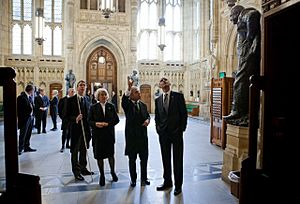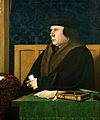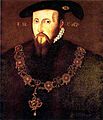Lord Great Chamberlain facts for kids
Quick facts for kids Lord Great Chamberlain of England |
|
|---|---|
|
Incumbent
Rupert Carington, 7th Baron Carrington since 8 September 2022 Joint hereditary officeholders
Cholmondeley share:
|
|
| Style | The Right Honourable |
| Appointer | The Monarch |
| Term length | At His Majesty's pleasure |
| Formation | c. 1126 |
| First holder | Robert Malet |
| Succession | Hereditary |
| Salary | Unpaid |
The Lord Great Chamberlain of England is a very old and important job in the United Kingdom. It's one of the six "Great Officers of State," which are special roles that help the King or Queen. This job started around the year 1126, during Norman times, and has been around ever since! The person who holds this job right now is Rupert Carington, 7th Baron Carrington.
Contents
What Does the Lord Great Chamberlain Do?
The Lord Great Chamberlain has a very important role looking after the Palace of Westminster. This is the famous building where the British Parliament meets. He acts as the King or Queen's representative inside the Palace.
Looking After the Palace of Westminster
The Lord Great Chamberlain is in charge of certain parts of the Palace of Westminster. These include the special rooms used by the King or Queen and the Central Lobby. He makes sure these areas are used, kept safe, and maintained properly. He also works with the Speaker of the House of Lords and the Speaker of the House of Commons to look after Westminster Hall and the Crypt Chapel.
Special Duties for the Monarch
The Lord Great Chamberlain also has other special duties. He helps introduce new members of the House of Lords (called peers and bishops) when they join. He also welcomes leaders from other countries when they visit the Palace of Westminster. Whenever the King or Queen is at Parliament, the Lord Great Chamberlain is there to help them. He makes sure everything is ready for the monarch's visit.
Role in the State Opening of Parliament
One of the most visible jobs of the Lord Great Chamberlain is during the State Opening of Parliament. This is a big, formal event where the King or Queen officially opens Parliament each year.
- He greets the King or Queen at the Norman Porch.
- He helps the monarch put on their special robes and the Imperial State Crown in the Robing Room.
- He then leads the King or Queen's procession through the Royal Gallery and Prince's Chamber into the Lords Chamber.
- Finally, the Lord Great Chamberlain tells "Black Rod" (another important official) to call the members of the House of Commons to come and listen to the King or Queen's speech.
Coronation Duties
The Lord Great Chamberlain also plays a big part in royal coronations. On coronation day, he has the special right to help dress the monarch. He also serves the monarch water before and after the coronation banquet. During the coronation ceremony, he helps the monarch put on the special symbols of their rule. For these grand events, he wears a bright red uniform and carries a gold key and a white staff. These are symbols of his important job.
Lord Great Chamberlain vs. Lord Chamberlain
It's easy to confuse the Lord Great Chamberlain with another job called the Lord Chamberlain of the Household. But they are actually quite different! The Lord Great Chamberlain's job is passed down through families (hereditary), and he mainly deals with Parliament. The Lord Chamberlain of the Household works directly for the King or Queen's personal household and is not a hereditary role. The Lord Chamberlain's job started later, in the 14th century, to help the Lord Great Chamberlain with household duties.
Special Rule for Hereditary Peers
In 1999, a law was passed that changed who could sit in the House of Lords. Most hereditary peers (people who inherited their titles) lost their automatic right to be there. However, the law made an exception for the Lord Great Chamberlain. This was so he could continue to perform his important ceremonial duties in Parliament.
How the Job is Passed Down
The job of Lord Great Chamberlain is hereditary, meaning it's passed down through families. Since 1780, it has been held "in gross," which means it's shared by several families.
Choosing Who Serves
Even though many people might have a small share of the office, only one person actually does the job at a time. These people are called "Joint Hereditary Lord Great Chamberlains." They choose one person, who must be a knight or higher, to be the "Deputy Lord Great Chamberlain." This person then performs the duties.
In 1912, the main families who shared the office made an agreement. They decided that the right to do the job would rotate among them for each new King or Queen's reign. The family of the Marquesses of Cholmondeley holds half of the office. This means they get to do the job, or choose someone to do it, every other reign. The other families take turns in the remaining reigns. If one of the family shares gets split even further, those family members have to agree among themselves who will be their deputy.
When King Charles III became King, it was the turn of the Carrington family's share. They chose their cousin, Rupert Carington, 7th Baron Carrington, to be the Lord Great Chamberlain.
History of This Important Role

The Lord Great Chamberlain's job started with a man named Robert Malet. His father was a close friend of William the Conqueror. But in 1133, King Henry I took the job away from Malet. The King then gave it to Aubrey de Vere, whose son later became the Earl of Oxford.
The De Vere Family's Turn
For many years, the Earls of Oxford from the De Vere family held the title almost continuously. Sometimes, they lost the job if an Earl was accused of treason. In 1526, the 14th Earl of Oxford died without a direct male heir. King Henry VIII then said the job belonged to the Crown (the King himself). He appointed the next Earl of Oxford to the job, but only for his lifetime, not as a hereditary role.
The De Vere family's connection to the job was broken again in 1540. Thomas Cromwell, the King's chief advisor, became Lord Great Chamberlain. But Cromwell was later executed, and the job passed to a few other people. In 1553, it returned to the De Vere family, again for the lifetime of the 16th Earl of Oxford. However, Queen Mary I later decided that the Earls of Oxford were entitled to the job as a hereditary right.
So, the 16th, 17th, and 18th Earls of Oxford held the position through their family line until 1626.
The Bertie Family Takes Over
In 1626, the 18th Earl of Oxford died. The House of Lords (a part of Parliament) decided that the job should go to the "heir general." This means the closest relative, even if it was a female line, not just the closest male relative. So, the job went to Robert Bertie, 1st Earl of Lindsey. The job then stayed with the Bertie family, who later became the Dukes of Ancaster and Kesteven.
Splitting the Office
In 1779, the 4th Duke of Ancaster and Kesteven died. He had two sisters as female heirs. The House of Lords ruled that these two sisters would jointly hold the job of Lord Great Chamberlain. They could then choose someone to do the actual work.
The job was split between the elder sister, Priscilla Bertie, 21st Baroness Willoughby de Eresby, and her younger sister, Georgiana. Priscilla's share has been split many more times among her descendants. Georgiana's share, however, has always gone to a single male heir. This person has always been the Marquess of Cholmondeley, a title created for Georgiana's husband.
20th and 21st Century Changes

In 1902, the House of Lords decided that the families who jointly held the office had to agree on a deputy to do the job. The King or Queen also had to approve this choice. If they couldn't agree, the monarch would choose a deputy until an agreement was reached.
In 1912, the families made an agreement that is still used today. The right to perform the duties of the Lord Great Chamberlain rotates among the three main families who share the office. This rotation happens at the start of each new King or Queen's reign. The Cholmondeley family (who hold half the office) gets to serve every other reign. The Ancaster and Carrington families each serve once every four reigns.
On May 6, 2023, the Lord Great Chamberlain presented golden spurs to King Charles III as part of his coronation ceremony. These spurs have been used in English coronations since 1189, when they were first used for Richard I.
Images for kids









































